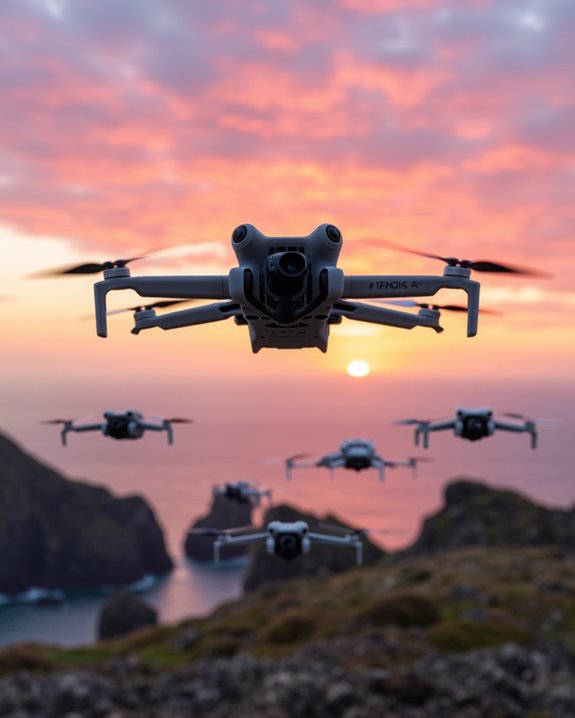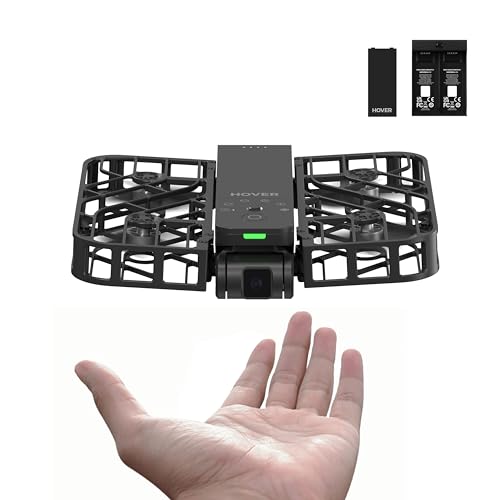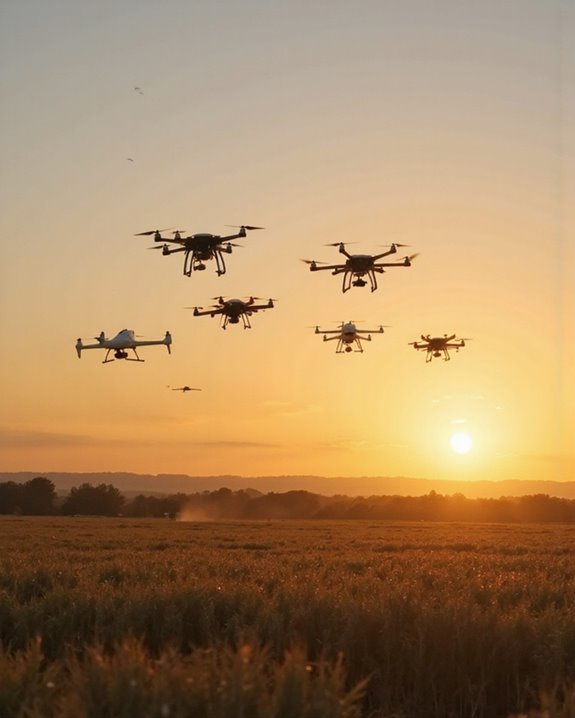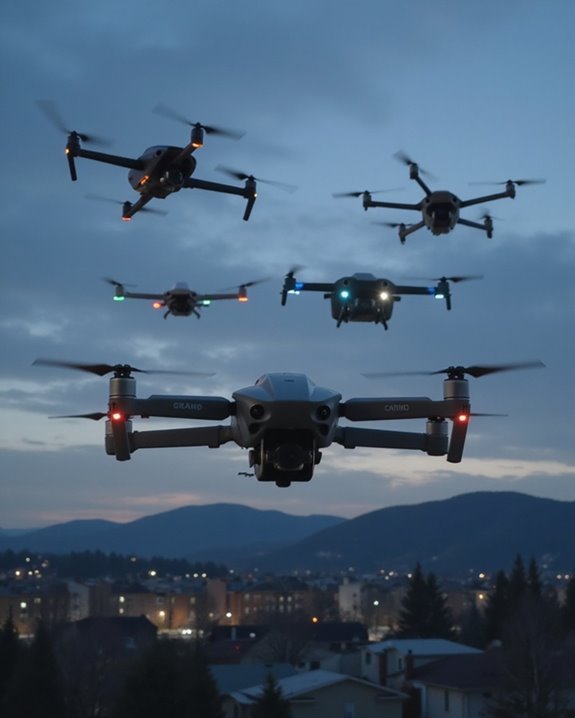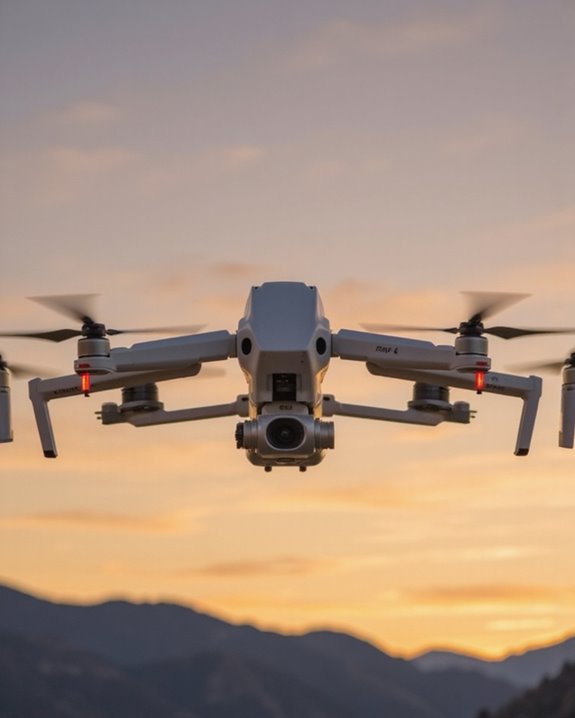You’ll find excellent options across all price points in today’s airplane drone market! The HOVERAir X1 offers sophisticated self-flying capabilities, while the Foam Drone RC UFO provides kid-friendly controls with auto-hovering. For photography enthusiasts, consider the Potensic ATOM or Holy Stone HS360E with their impressive 4K cameras and GPS features. Beginners might prefer the Foam Drone RC Airplane with its durable construction and forgiving flight characteristics. Each model balances unique features with specific user needs—your perfect aerial companion awaits below!
Key Takeaways
- HOVERAir X1 offers intelligent flight paths, hands-free aerial footage, and compact foldable design ideal for content creators and travelers.
- Foam Drone RC UFO provides beginner-friendly features like one-key takeoff and auto-hovering, making it perfect for young users ages 7-8.
- Potensic ATOM 4K GPS Drone delivers professional-quality footage with its 3-axis gimbal and weighs under 249g, avoiding FAA registration requirements.
- Holy Stone HS360E 4K GPS Drone features advanced GPS functions including auto-return and follow-me mode with stable 4K video capture.
- Foam Drone RC Airplane combines safety features with stunt capabilities, providing an excellent entry-level aircraft for children 8+ with two batteries included.
X1 Self-Flying Camera Drone with HDR Video Capture
The HOVERAir X1 is a pocket-sized powerhouse that’s perfect for content creators who need hands-free filming without the learning curve of traditional drones. You’ll love its palm takeoff feature and intelligent flight paths that make capturing your adventures effortless! At just 1.54 pounds with foldable design, it slips into your pocket yet delivers impressive 2.7K HDR video.
Users report the X1 outperforms the DJI Neo with better algorithms and stylish design. Its follow-me mode tracks your movements with remarkable stability, making it ideal for weddings, travel vlogs, and social media content. While some early users experienced battery issues, the company has been responsive with replacements. For hands-free aerial cinematography that won’t break the bank, this little marvel delivers big results!
Best For: Content creators, travelers, and social media enthusiasts who want hassle-free aerial footage without learning complex drone controls.
Pros:
- Palm takeoff and intelligent flight paths make operation incredibly simple with no learning curve
- Compact and lightweight (1.54 pounds) with foldable design that fits in a pocket
- Follow-me mode provides stable tracking footage with better algorithms than competitors like DJI Neo
Cons:
- Some users reported battery issues and unexpected crashes, though company offers replacements
- Landing functionality needs improvement according to user feedback
- Limited to 2.7K video resolution, which may not satisfy professional videographers requiring 4K
Foam Drone RC UFO for Kids with Remote Control and Auto Hovering
- Kid-Safe & Durable Design: Made from lightweight yet sturdy foam material, this ufo drone is built to withstand crashes while staying safe for kids. The fully enclosed...
- Stunning LED Light Show with 4 Modes: Equipped with 24 LED lights in 8 vibrant colors, this UFO drone offers four lighting modes: constant, alternating, flashing, and...
- Beginner-Friendly Operation: Designed for easy flying, with One-Key Takeoff/Landing and Auto-Hovering for stable flight. Headless Mode allows intuitive control regardless...
Parents searching for a child’s first flying toy will find the HOLYFUN Foam Drone RC UFO strikes the perfect balance between fun and safety. Its lightweight foam construction and protective propeller guards keep little fingers safe during inevitable crashes.
You’ll love the beginner-friendly features, including one-key take-off, auto-hovering, and three adjustable speeds that grow with your child’s skill level. The impressive 24 LED lights with 8 colors create quite the light show during evening flights! While some users note issues with propeller durability, most agree the easy controls build confidence in young pilots ages 7-8. With 15 minutes of flight time per battery, you’re getting a solid introduction to the drone world.
Best For: Young beginners ages 7-8 who want a safe, easy-to-operate first drone with impressive light features and protective design.
Pros:
- Lightweight foam construction with propeller guards ensures safety during inevitable crashes
- User-friendly controls including one-key take-off, auto-hovering, and three adjustable speeds that grow with skill level
- Impressive light show capability with 24 LED lights in 8 colors and 4 display modes
Cons:
- Propellers break easily and replacement parts are difficult to obtain
- Limited 15-minute flight time per battery charge
- Some users report motor failure after approximately one month of regular use
Potensic ATOM 4K GPS Drone with 3-Axis Gimbal
- 【𝐋𝐢𝐠𝐡𝐭𝐰𝐞𝐢𝐠𝐡𝐭, 𝐥𝐞𝐬𝐬 𝐭𝐡𝐚𝐧 𝟐𝟒𝟗𝐠】 The palm-sized drone, ATOM, 𝐝𝐨𝐞𝐬𝐧'𝐭...
- 【𝐑𝐨𝐜𝐤 𝐒𝐭𝐞𝐚𝐝𝐲 𝟒𝐊 𝟑-𝐀𝐱𝐢𝐬 𝐆𝐢𝐦𝐛𝐚𝐥】Equipped with 𝐒𝐎𝐍𝐘 𝐂𝐌𝐎𝐒...
- 【𝟏.𝟑𝐇 𝐅𝐚𝐬𝐭 𝐂𝐡𝐚𝐫𝐠𝐞, 𝟗𝟔 𝐌𝐢𝐧𝐬 𝐋𝐨𝐧𝐠 𝐅𝐥𝐢𝐠𝐡𝐭 𝐰𝐢𝐭𝐡 𝟑...
Weighing a featherlight 8.8 ounces, Potensic’s ATOM 4K GPS Drone delivers professional-quality aerial photography in a palm-sized package that won’t weigh down your adventure pack! You’ll capture stunning footage with its SONY CMOS sensor and 3-axis gimbal that stays steady even in level-5 windy conditions.
Enjoy an impressive 96 minutes of flight time with the three included batteries, and get back in the air quickly thanks to the 60W parallel charging hub. The drone’s QuickShots features (Pull-Away, Rocket, Circle, Spiral, Boomerang) make capturing cinematic videos a breeze, even if you’re a beginner! With 6km transmission range and no FAA registration required, you’re ready for takeoff right out of the box.
Best For: Photography enthusiasts and travelers seeking a lightweight, powerful drone that delivers professional-quality 4K footage without requiring FAA registration.
Pros:
- Ultralight design under 249g eliminates FAA registration requirements while providing impressive 96-minute flight time with three batteries
- Professional-grade camera setup with SONY CMOS sensor and 3-axis gimbal stabilization captures steady 4K footage even in windy conditions
- Beginner-friendly with multiple automated QuickShots features and a substantial 6km transmission range
Cons:
- Relatively new product (released October 2023) may have undiscovered issues or limited user feedback despite positive initial ratings
- Three batteries require 1.3 hours for a full charge, potentially limiting continuous all-day shooting sessions
- Palm-sized design, while portable, may be more susceptible to stronger winds despite gimbal stabilization
Holy Stone HS360E 4K GPS Drone with Camera
- Upgraded Drone for Adults: The 𝐇𝐨𝐥𝐲 𝐒𝐭𝐨𝐧𝐞 𝐇𝐒𝟑𝟔𝟎𝐄 is the 𝐞𝐧𝐡𝐚𝐧𝐜𝐞𝐝 𝐯𝐞𝐫𝐬𝐢𝐨𝐧...
- 𝟒𝐊 𝐄𝐈𝐒 𝐂𝐚𝐦𝐞𝐫𝐚 with 𝟏𝟐𝟎𝟎𝐖 𝐒𝐞𝐧𝐬𝐨𝐫: Capture professional-level videos and photos with the drone’s 4K...
- 𝟐𝟎,𝟎𝟎𝟎𝐟𝐭 𝐋𝐨𝐧𝐠-𝐑𝐚𝐧𝐠𝐞 𝐓𝐫𝐚𝐧𝐬𝐦𝐢𝐬𝐬𝐢𝐨𝐧: Enjoy long-distance control and real-time video with...
Featuring a stunning 4K camera with electronic image stabilization, the Holy Stone HS360E represents an ideal choice for photography enthusiasts seeking professional-quality aerial imagery without FAA registration hassles. At just 249g, you’ll never need to register this drone with the FAA, yet you’ll still enjoy impressive capabilities that rival much heavier models!
You’ll appreciate the 20,000ft transmission range and intelligent flight modes like follow-me and waypoint navigation. The 1503 brushless motors deliver stable flight while the 2100mAh battery provides adequate flight time. With RAW and JPEG photo options, you’re equipped to capture crystal-clear shots that’ll impress your friends and family. The complete package includes everything you need to start flying immediately!
Best For: Photography enthusiasts looking for a lightweight, FAA-registration-free drone with professional-quality 4K imaging capabilities and intelligent flight modes.
Pros:
- Ultralight 249g design eliminates FAA registration requirements while maintaining impressive 4K EIS camera quality
- Advanced features like GPS auto-return, follow-me mode, and waypoint navigation enhance creative possibilities
- Complete ready-to-fly package includes carrying case, spare propellers, and all necessary components
Cons:
- 2100mAh battery capacity may limit flight time compared to larger, heavier drones
- Maximum range of 4 miles requires maintaining line of sight for legal operation in most regions
- At #66,925 in Toys ranking, it may not be as popular or widely reviewed as leading drone models
Foam Drone RC Airplane for Kids and Beginners
- The rc airplane is not suitable for windy outdoor conditions, as it will be difficult to control.
- Durable & Safe Foam Design: Made from lightweight yet sturdy foam, this RC plane drone ensures long-lasting performance. The enclosed propeller guard enhances safety for...
- Fun & Versatile Flight Maneuvers: Experience exciting flying tricks like 360°flips, auto rotation, and circular flying. Supports forward, backward, and lateral...
The HOLYFUN Foam Drone RC Airplane offers an ideal entry point for young aviation enthusiasts who aren’t quite ready for complex flying machines. At just 10 inches, this fighter jet-style drone packs impressive features including colorful lights for day or night flying and multiple stunt options.
You’ll appreciate the thoughtful safety features—lightweight foam construction and protective propeller guards keep both the drone and little fingers safe! With three adjustable speeds, one-key takeoff/landing, and headless mode, even first-time pilots can feel like aces. The package includes two rechargeable batteries providing up to 18 minutes of airtime, perfect for those “just one more flight” moments that inevitably happen!
Best For: Parents seeking a fun, entry-level RC aircraft for kids 8+ that offers safety features, easy controls, and exciting stunt capabilities without requiring advanced piloting skills.
Pros:
- Lightweight foam construction with propeller guards ensures durability while minimizing risk of injury during inevitable crashes
- Impressive feature set including one-key controls, headless mode, and multiple stunts makes flying accessible even for complete beginners
- Includes two rechargeable batteries that provide up to 18 minutes of total flight time with colorful lights for day/night flying
Cons:
- 164-foot maximum control range is relatively limited compared to more advanced RC aircraft
- Not suitable for use in windy conditions, restricting when and where it can be flown
- Some users report shorter-than-advertised battery life, which may disappoint enthusiastic young pilots
Factors to Consider When Choosing an Airplane Drone
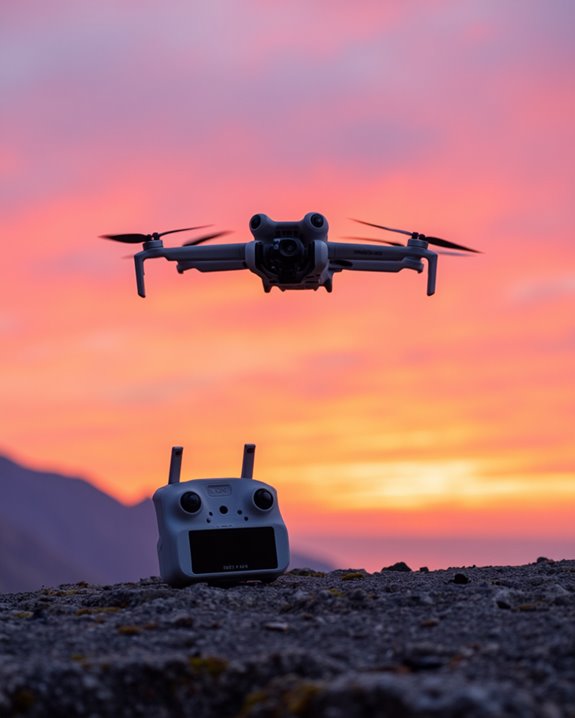
Choosing the perfect airplane drone isn’t just about finding something that flies—it’s about matching features to your specific needs! You’ll want to evaluate essential factors like camera quality, battery life, size, control range, and wind resistance, which all impact your flying experience. These key considerations will help you narrow down the overwhelming options and find an aircraft that’s right for your budget, skill level, and intended use.
Camera Quality and Resolution
When capturing breathtaking aerial views, camera quality and resolution stand as essential factors that can make or break your drone photography experience! You’ll want to evaluate the difference between 4K and 1080p options, with 4K delivering nearly four times the detail for those jaw-dropping landscape shots. Modern CMOS sensors have revolutionized drone photography, giving you clearer images even as the sun starts to set.
Don’t overlook stabilization features! Electronic image stabilization (EIS) keeps your footage silky smooth, even when those level 5 winds try to ruin your perfect shot. Frame rates matter too—opt for 60fps when you’re filming fast-moving subjects like cars or wildlife. And remember, HDR capabilities will save your footage when you’re flying between bright skies and shadowy terrain. Your future self will thank you!
Flight Time and Battery
For airplane drone enthusiasts, battery life represents the invisible countdown that determines how long your aerial adventures will last! Most single batteries provide just 15-18 minutes of flight time, which can vanish in the blink of an eye when you’re capturing that perfect aerial shot. You’ll want to evaluate models that support multiple batteries, as some setups can extend your airtime to an impressive 96 minutes without interruption.
Battery capacity matters tremendously – look for higher mAh ratings between 450 and 2230, with the upper range delivering substantially longer sessions. Don’t overlook drones with helpful low battery alerts (those flashing lights are lifesavers when you’re distracted by amazing views!). Rechargeable options with 2100 mAh capacity typically recharge in about an hour, meaning you’ll spend less time waiting and more time flying!
Size and Portability
The perfect airplane drone transforms from a robust flying machine into a travel-friendly companion that fits right in your backpack! When you’re constantly on the move, size truly matters—and today’s top models deliver impressive portability without sacrificing performance.
Look for those clever foldable designs that collapse down to pocket-size dimensions, making storage a breeze! Drones under 250 grams aren’t just easier to carry; they’ll save you headaches with fewer registration requirements. Most portable options measure less than 12 inches across, with the lightest weighing a mere 8-10 ounces—practically featherweight!
Don’t overlook protective cases, which might add bulk but guarantee your aerial buddy arrives at your destination unscathed. After all, what good is a compact drone if it’s damaged before takeoff? Your ideal choice strikes that perfect balance between powerful features and slip-it-in-your-bag convenience.
Control Range and Connectivity
Imagine soaring your drone beyond the horizon, maintaining perfect control while capturing breathtaking footage from miles away! When selecting your airplane drone, control range should be at the top of your checklist.
Basic models offer around 50 meters of range, while premium drones can reach several kilometers—perfect for those ambitious aerial adventures! You’ll want to evaluate the connectivity technology too. Wi-Fi works for beginners, but 2.4GHz radio frequency systems deliver superior anti-interference in crowded areas. Trust me, nothing’s more frustrating than losing signal mid-flight!
Remember that real-world conditions can reduce your effective range by up to 30%, so always choose a drone with some buffer. Look for models with auto-return features that activate when signals weaken—your drone will find its way home, even when you can’t guide it there!
Stability and Wind Resistance
When turbulent air currents threaten to toss your drone like a paper airplane, stability features become your flight’s best friend! Look for models with auto-hovering capabilities that maintain position even when gusts try to push your aircraft off course. You’ll appreciate the difference brushless motors make, providing consistent thrust that keeps your drone steady when winds pick up.
Don’t overlook electronic image stabilization (EIS) technology, which compensates for those pesky external forces while capturing buttery-smooth video footage. Surprisingly, lighter drones (under 250 grams) often handle wind better due to their reduced surface area—less for the wind to grab onto! The smartest airplane drones today come equipped with intelligent flight modes that automatically adjust to changing wind conditions, so you’re not constantly fighting the controls. Your aerial adventures shouldn’t end because of a little breeze!
Safety Features
Why risk your investment—or worse, someone’s safety—when today’s airplane drones come packed with protective innovations? Propeller guards are your first line of defense, shielding curious fingers from spinning blades and protecting your drone when it inevitably meets a tree branch.
You’ll want to prioritize models with reliable auto-hovering capabilities, which keep your aircraft steady even when your piloting skills aren’t! Headless mode is a beginner’s best friend, letting you control the drone based on your perspective rather than trying to figure out which way the drone is facing. Don’t overlook low battery alerts—those flashing lights might save your drone from an unexpected nosedive into your neighbor’s pool. Finally, GPS auto-return features are absolute lifesavers, ensuring your drone finds its way home when it wanders too far from your signal.
Skill Level Requirements
The perfect airplane drone matches your current abilities while leaving room to grow! When you’re just starting out, look for models featuring auto-hover, one-key take-off, and headless mode—these features will help you build confidence without frustration. Remember, even seasoned pilots started somewhere!
You’ll want adjustable speed settings that let you begin in “turtle mode” before gradually working up to those exhilarating high-speed flights. Don’t worry about mastering everything at once! For beginners, propeller guards aren’t just accessories—they’re your drone’s insurance policy and your peace of mind.
As your skills improve, you might crave more advanced features like GPS-assisted flight paths. These sophisticated functions require greater navigation understanding, but they’re worth the learning curve. The joy of piloting comes from matching the right drone to your skill level!
Frequently Asked Questions
How Long Does It Take to Learn Flying an Airplane Drone?
Practice makes perfect when learning to fly an airplane drone! You’ll need about 2-4 weeks to master basic controls if you’re practicing 30 minutes daily. Start with simulator apps to build muscle memory, then progress to beginner-friendly models with stability features. Your learning curve depends on your hand-eye coordination and the drone’s complexity. Many pilots find they’re comfortable with basic maneuvers after just a few sessions, but advanced tricks might take months to perfect!
Are Permits Required for Flying Airplane Drones in Residential Areas?
Yes, you’ll typically need permits to fly drones in residential areas! In the US, any drone over 0.55 pounds requires FAA registration, and you must follow strict guidelines about altitude (stay below 400 feet), visibility, and no-fly zones. Many cities have additional local ordinances that restrict drone use, especially in neighborhoods. Check your local regulations before takeoff, as some areas require special permission or completely prohibit residential drone flying—nobody wants an unexpected visit from law enforcement during their aerial adventures!
Can Airplane Drones Operate Safely in Windy Conditions?
Yes, airplane drones can operate in windy conditions, but with limitations! Most consumer drones handle winds up to 10-15 mph, while professional models can tackle gusts of 20-35 mph. You’ll need to check your specific drone’s wind rating before flying. Remember, even if your drone can technically handle wind, you’ll experience reduced flight time, limited control precision, and potentially shakier video footage. For best results, always monitor local weather forecasts and avoid flying when conditions approach your drone’s limits.
How Often Should Drone Motors and Propellers Be Replaced?
You should replace your drone motors every 50-100 flight hours, depending on how hard you’re pushing them. Propellers need more frequent attention—inspect them before every flight and replace at the first sign of cracks, chips, or bending! With regular use, most pilots swap propellers every 20-30 flights. Remember, your maintenance schedule may vary based on your flying style, drone model, and conditions. Flying in dusty or coastal environments? You’ll need to replace components more often!
What Backup Systems Exist if GPS Signal Is Lost?
When GPS goes dark, you’re not flying blind! Your drone can rely on several backup systems to keep you soaring. Inertial Navigation Systems (INS) track movement using accelerometers and gyroscopes, while Visual Positioning Systems use cameras to identify landmarks below. Some advanced drones feature terrain recognition technology, ultrasonic sensors for obstacle detection, and Return-to-Home functions that remember your takeoff point. For serious pilots, there’s even celestial navigation that uses star positions – talk about reaching for the stars!

